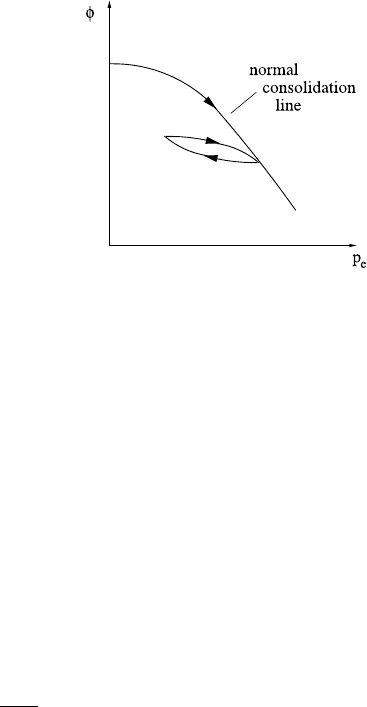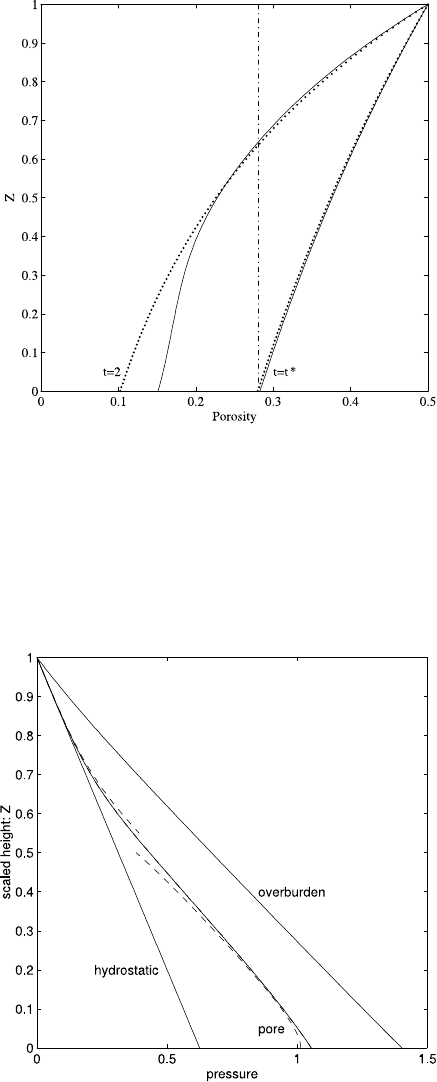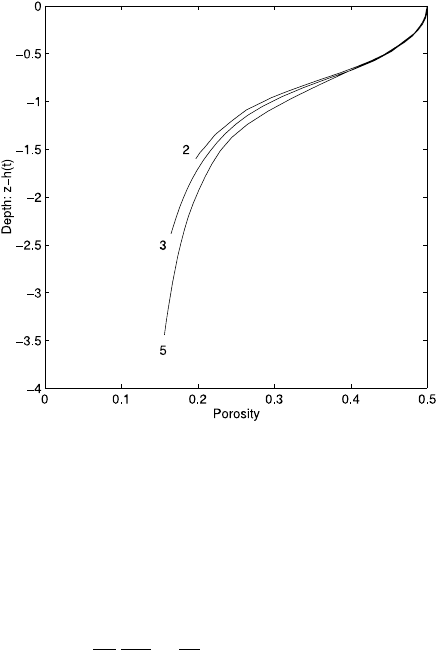Fowler A. Mathematical Geoscience
Подождите немного. Документ загружается.


440 7 Groundwater Flow
Various possibilities can now occur depending on the values of the different solu-
bility limits. We suppose that the solubility of hydrous silica X with respect to illite
is much less than that with respect to smectite (thus θ
X
1), and we suppose this
is also true for potassium, that is to say, θ
K
1. On the other hand, we suppose
that the solubilities of silica with respect to feldspar or quartz are comparable, so
that θ
L
∼ 1, and in fact we will take θ
L
> 1 as appears to be appropriate (indeed
otherwise the smectite–illite transition will not occur in this model).
The equilibrium equations (7.229)are
φ
S
R
SD
[1 −ψ
X
]
+
=fr
3
,
φ
F
R
FD
[1 −ψ
K
]
+
[θ
L
−ψ
L
]
+
=r
3
,
φ
Q
R
QP
[ψ
L
−1]
+
−φ
Q
R
QD
[1 −ψ
L
]
+
=(s +1)r
3
,
r
3
=φ
I
R
IP
[ψ
K
−θ
K
]
+
[ψ
X
−θ
X
]
+
,
(7.236)
and these are four equations for the reaction rate r
3
and the three aqueous concen-
trations ψ
X
, ψ
L
and ψ
K
. Assuming non-zero reaction rates, and taking θ
K
,θ
X
1,
and θ
L
> 1, we deduce from (7.236) that ψ
L
> 1 (thus quartz precipitates from
solution), and
r
3
=φ
I
R
IP
ψ
K
ψ
X
,
ψ
X
=1 −
fr
3
φ
S
R
SD
,
ψ
L
=1 +
(s +1)r
3
φ
Q
R
QP
,
ψ
K
=1 −
r
3
φ
F
R
FD
θ
L
−1 −
(s+1)r
3
φ
Q
R
QP
,
(7.237)
whence the basic reaction rate r
3
is determined by
r
3
=φ
I
R
IP
1 −
fr
3
φ
S
R
SD
1 −
r
3
φ
F
R
FD
θ
L
−1 −
(s+1)r
3
φ
Q
R
QP
. (7.238)
The right hand side of this expression is a decreasing function of r
3
if it is positive,
while the left hand side is increasing; therefore this expression defines the rate r
3
uniquely in terms of the solid phase concentrations of feldspar, quartz, smectite and
illite.
A general complication in solving for φ
S
and the other reactant porosities is that
r
3
depends on φ
S
,φ
I
,φ
Q
and φ
F
.Givenu
s
,(7.230) is a hyperbolic equation for φ
S
with boundary condition φ
S
=φ
0
S
on the upper surface z =h of a sedimentary basin
b<z<h. The equations for the solid fractions φ
Y
, Y = S,I,Q,F are all of the
form
∂φ
Y
∂t
+∇.
φ
Y
u
s
=α
Y
r
3
, (7.239)

7.10 Consolidation 441
for certain constants α
Y
, and if φ
Y
=φ
0
Y
on z =h, then φ
Y
can be written as a linear
combination of φ
S
and φ
I
,
φ
Y
=
(α
Y
φ
0
S
+φ
0
Y
)φ
I
+(α
I
φ
0
Y
−α
Y
φ
0
I
)φ
S
α
I
φ
0
S
+φ
0
I
. (7.240)
Therefore, the reaction rate r
3
can generally be written explicitly as a function of φ
S
and φ
I
, and the diagenesis model collapses to equations for φ
S
,φ
I
and φ, together
with Darcy’s law.
Diagenesis (at least in this theory) turns out to have a minor quantitative effect
on groundwater flow, essentially because the source term in (7.232) is relatively
small. What is perhaps of more interest is that a fairly complicated sequence of
precipitation/dissolution steps can be reduced, in the limit of weak solubility, to a
model with first order kinetics, albeit with a complicated (but explicitly defined)
reaction rate. In fact, this observation is likely to be true in general. Suppose we
have a sequence of precipitation and dissolution steps for solids S
i
and liquids L
j
:
L
1
+···
R
1
−→ S
1
+···,
S
2
+···
R
2
−→ L
2
+···.
(7.241)
Each reaction step necessarily involves at least one aqueous phase component, and
thus all the reaction rates R
1
,...,R
n
occur in the conservation equations for the
aqueous phase components. Since these can all be taken to be in equilibrium, then
if there are k different aqueous phase components, we obtain k relations for the n
reactions. If k = n − 1, then all the reaction rates can be written in terms of the
overall production rate, and first order kinetics will apply.
In the present example (7.226), there are five reaction steps, and three aqueous
components (lumping K
+L
and Al(OH)
−L
4
together), but the precipitation/dissolu-
tion of quartz is effectively one reaction (either but not both at once can occur),
and so the condition n = k +1 is effectively met. More generally, we see that the
production of solid precipitate P from solid substrates S through a sequence of
intermediate dissolution/precipitation steps may often lead to this situation.
7.10 Consolidation
Consolidation refers to the ability of a granular porous medium such as a soil to
compact under its own weight, or by the imposition of an overburden pressure. The
grains of the medium rearrange themselves under the pressure, thus reducing the
porosity and in the process pore fluid is expelled. Since the porosity is no longer
constant, we have to postulate a relation between the porosity φ and the pore pres-
sure p. In practice, it is found that soils, when compressed, obey a (non-reversible)
relation between φ and the effective pressure
p
e
=P −p, (7.242)
where P is the overburden pressure.

442 7 Groundwater Flow
Fig. 7.11 Form of the
relationship between porosity
and effective pressure. A
hysteretic decompression-re-
consolidation loop is
indicated. In soil mechanics
this relationship is often
written in terms of the void
ratio e =φ/(1 −φ),and
specifically
e =e
0
−C
c
logp
e
,whereC
c
is the compression index
The concept of effective pressure, or more generally effective stress, is an ex-
tremely important one. The idea is that the total imposed pressure (e.g., the overbur-
den pressure due to the weight of the rock or soil) is borne by both the pore fluid and
the porous medium. The pore fluid is typically at a lower pressure than the overbur-
den, and the extra stress (the effective stress) is that which is applied through grain
to grain contacts. Thus the effective pressure is that which is transmitted through
the porous medium, and it is in consequence of this that the medium responds to the
effective stress; in particular, the characteristic relation between φ and p
e
represents
the nonlinear pseudo-elastic effect of compression.
As p
e
increases, so φ decreases, thus we can write (ignoring irreversibility)
p
e
=p
e
(φ), p
e
(φ) < 0. (7.243)
Taking the fluid density ρ to be constant, we obtain from the conservation of mass
equation the nonlinear diffusion equation
φ
t
=∇.
k(φ)
μ
p
e
(φ)
∇φ
, (7.244)
assuming Darcy’s law with a permeability k, ignoring gravity, and taking P as con-
stant. This is essentially the same as the Richards equation for unsaturated soils.
The dependence of the effective pressure on porosity is non-trivial and involves
hysteresis, as indicated in Fig. 7.11. Specifically, a soil follows the normal consol-
idation line providing consolidation is occurring, i.e. ˙p
e
> 0. However, if at some
point the effective pressure is reduced, only a partial recovery of φ takes place.
When p
e
is increased again, φ more or less retraces its (overconsolidated) path to
the normal consolidation line, and then resumes its normal consolidation path. Here
we will ignore effects of hysteresis, as in (7.243).
When modelling groundwater flow in a consolidating medium, we must take
account also of deformation of the medium itself. In turn, this requires prescription
of a constitutive rheology for the deformable matrix. This is often a complex matter,
but luckily in one dimension, the issue does not arise, and a one-dimensional model
is often what is of practical interest. We take z to point vertically upwards, and let v
l

7.10 Consolidation 443
and v
s
be the linear (or phase-averaged) velocities of liquid and solid, respectively.
Then u
l
= φv
l
and u
s
= (1 −φ)v
s
are the respective fluxes, and conservation of
mass of each phase requires
∂φ
∂t
+
∂(φv
l
)
∂z
=0,
−
∂φ
∂t
+
∂{(1 −φ)v
s
}
∂z
=0;
(7.245)
Darcy’s law is then
φ
v
l
−v
s
=−
k
μ
∂p
∂z
+ρ
l
g
, (7.246)
while the overburden pressure is
P = P
0
+
ρ
s
(1 −φ) +ρ
l
φ
g(h −z); (7.247)
here z =h represents the ground surface and P
0
is the applied load. (7.247) assumes
variations of φ are small. More generally, we would have ∂P/∂z =−[ρ
s
(1 −φ) +
ρ
l
φ]g. The effective pressure is then just p
e
=P −p.
We suppose these equations apply in a vertical column 0 <z<h,forwhich
suitable boundary conditions are
v
l
=v
s
=0atz =0,
p =0,
˙
h =v
s
at z =h,
(7.248)
and with an initial condition for p (or φ).
The two mass conservation equations imply
v
s
=−
φv
l
1 −φ
. (7.249)
Substituting this into (7.246), we derive, using (7.245),
∂φ
∂t
=
∂
∂z
k
μ
(1 −φ)
∂p
∂z
+ρ
l
g
. (7.250)
If we assume the normal consolidation line takes the commonly assumed form (see
Fig. 7.11)
φ
1 −φ
=e
0
−C
c
ln
p
e
/p
0
e
, (7.251)
then we derive the consolidation equation
∂p
e
∂t
=
p
e
C
c
(1 −φ)
2
∂
∂z
k
μ
(1 −φ)
∂p
e
∂z
+ρ (1 −φ)g
, (7.252)
where ρ =ρ
s
−ρ
l
.

444 7 Groundwater Flow
If C
c
is small (and typical values are in the range C
c
≤0.1) then φ varies little,
and the consolidation equation takes the simpler form
∂p
e
∂t
=c
v
∂
2
p
e
∂z
2
, (7.253)
where
c
v
=
k
μ
p
e
C
c
(1 −φ)
(7.254)
is the coefficient of consolidation.
Suitable boundary conditions are
∂p
e
∂z
+ρ (1 −φ)g =0atz =0,
p
e
=P
0
at z =h,
(7.255)
and if the load is applied at t = 0, the initial condition is
p
e
=ρ (1 −φ)g(h −z) at t =0. (7.256)
The equation is trivially solved. The consolidation time is
t
c
∼
h
2
c
v
=
μC
c
(1 −φ)h
2
kp
e
, (7.257)
and depends primarily on the permeability k.Ifwetakek ∼ 10
−14
m
2
(silt),
C
c
=0.1, φ = 0.3, μ = 10
−3
Pa s, P
0
= 10
5
Pa (a small house), then c
v
∼
10
−5
m
2
s
−1
, and t
e
∼1 year for h ∼10 m.
7.11 Compaction
Compaction is the same process as consolidation, but on a larger scale. Other mech-
anisms can cause compaction apart from the rearrangement of sediments: pressure
solution in sedimentary basins, grain creep in partially molten mantle (see Chap. 9).
The compaction of sedimentary basins is a problem which has practical conse-
quences in oil-drilling operations, since the occurrence of abnormal pore pressures
can lead to blow-out and collapse of the borehole wall. Such abnormal pore pres-
sures (i.e., above hydrostatic) can occur for a variety of reasons, and part of the
purpose of modelling the system is to determine which of these are likely to be
realistic causes. A further distinction from smaller scale consolidation is that the
variation in porosity (and, particularly, permeability) is large.
The situation we consider was shown in Fig. 7.10. Sediments, both organic and
inorganic, are deposited at the ocean bottom and accumulate. As they do so, they
compact under their weight, thus expelling pore water. If the compaction is fast (i.e.,

7.11 Compaction 445
the rate of sedimentation is greater than the hydraulic conductivity of the sediments)
then excess pore pressure will occur.
Sedimentary basins, such as the North Sea or the Gulf of Mexico, are typically
hundreds of kilometres in extent and several kilometres deep. It is thus appropriate
to model the compacting system as one-dimensional. A typical sedimentation rate
is 10
−11
ms
−1
, or 300 m My
−1
, so that a 10 kilometre deep basin may accumulate
in 30 My (30 million years). On such long time scales, tectonic processes are im-
portant, and in general accumulation is not a monotonic process. If tectonic uplift
occurs so that the surface of the basin rises above sea level, then erosion leads to de-
nudation and a negative sedimentation rate. Indeed, one purpose of studying basin
porosity and pore pressure profiles is to try and infer what the previous subsidence
history was—an inverse problem.
The basic mathematical model is that of slow two-phase flow, where the phases
are solid and liquid, and is the same as that of consolidation theory. The effec-
tive pressure p
e
is related, in an elastic medium, to the porosity by a function
p
e
= p
e
(φ). In a soil, or for sediments near the surface up to depths of perhaps
500 m, the relation is elastic and hysteretic. At greater depths, more than a kilo-
metre, pressure solution becomes important, and an effective viscous relationship
becomes appropriate, as described below. At greater depths still, cementation oc-
curs and a stiffer elastic rheology should apply.
15
In addition, the permeability is a
function k =k(φ) of porosity, with k decreasing to zero fairly rapidly as φ decreases
to zero.
Let us suppose the basin overlies an impermeable basement at z =0, and that its
surface is at z =h; then suitable boundary conditions are
v
s
=v
l
=0atz =0,
p
e
=0,
˙
h =˙m
s
+v
s
at z =h,
(7.258)
where v
s
and v
l
are solid and liquid average velocities, and ˙m
s
is the prescribed
sedimentation rate, which we take for simplicity to be constant.
If we assume a specific elastic compactive rheology of the form
p
e
=p
0
ln(φ
0
/φ) −(φ
0
−φ)
, (7.259)
then non-dimensionalisation (using a depth scale d =
p
0
(ρ
s
−ρ
l
)g
and a time scale
d
˙m
s
)
and simplification of the model leads to the nonlinear diffusion equation, analogous
to (7.250),
∂φ
∂t
=λ
∂
∂z
˜
k(1 −φ)
2
1
φ
∂φ
∂z
−1
, (7.260)
where the permeability is defined to be
k =k
0
˜
k(φ), (7.261)
k
0
being a suitable scale for k.
15
Except that at elevated temperatures, creep deformation will start to occur.

446 7 Groundwater Flow
The dimensionless parameter λ is given by
λ =
K
0
˙m
s
, (7.262)
where K
0
= k
0
(ρ
s
− ρ
l
)g/μ is essentially the surface hydraulic conductivity, and
we can then distinguish between slow compaction (λ 1) and fast compaction
(λ 1). Typical values of λ depend primarily on the sediment type. For ˙m
s
=
10
−11
ms
−1
,wehaveλ ≈0.1 for the finest clay, λ ≈10
9
for coarse sands. In gen-
eral, therefore, we can expect large values of λ. The associated boundary conditions
for the model become
φ
z
−φ =0atz =0,
φ =φ
0
,
˙
h =1 +λ
˜
k(1 −φ)
1
φ
∂φ
∂z
−1
at z =h.
(7.263)
Slow Compaction, λ 1 When λ is small, overpressuring occurs. A boundary
layer analysis is easy to do, and shows that φ ≈φ
0
in the bulk of the (uncompacted)
sediment, while a compacting boundary layer of thickness
√
λt exists at the base.
Fast Compaction, λ 1 The more realistic case of fast compaction is also the
more mathematically interesting. Most simply, the solution when λ 1 is the equi-
librium profile
φ =φ
0
exp[h −z]; (7.264)
the exponential decline of porosity with depth is sometimes called an Athy profile,
but it only applies while λ
˜
k 1. If we assume a power law for the dimensionless
permeability of the form
˜
k =(φ/φ
0
)
m
, (7.265)
then we find that λ
˜
k reaches one when φ decreases to a value
φ
∗
=φ
0
exp
−
1
m
ln λ
, (7.266)
and this occurs at a dimensionless depth
Π =
1
m
lnλ (7.267)
and time
t
∗
=
Π −φ
0
(1 −e
−Π
)
1 −φ
0
. (7.268)
Typical values m = 8, λ = 100, φ
0
= 0.5, give values φ
∗
= 0.28, Π = 0.58, t
∗
=
0.71. In particular, for a reasonable depth scale of 1 km (corresponding to p
0
=
2 ×10
7
Pa =200 bars), this would correspond to a depth of 580 m. Below this, the

7.11 Compaction 447
Fig. 7.12 Solution of (7.260)
for λ =100 at times
t = t
∗
≈0.71 and at t =2.
The porosity (horizontal axis)
is plotted as a function of the
scaled vertical height z/h(t).
The solid lines are numerical
solutions, whereas the dotted
lines are the large λ
equilibrium profiles. There is
a clear divergence at depth for
t>t
∗
profile is not equilibrated, and the pore pressure is elevated. Figure 7.12 shows the
resulting difference in the porosity profiles at t =t
∗
and t>t
∗
, and Fig. 7.13 shows
the effect on the pore pressure, whose gradient changes abruptly from hydrostatic to
lithostatic at the critical depth.
Fig. 7.13 Hydrostatic,
overburden (lithostatic) and
pore pressures at t =5and
λ =100, as functions of the
scaled height z/h(t).The
transition from equilibrium to
non-equilibrium compaction
at the critical depth is
associated with a transition
from normal to abnormal
pore pressures. The dashed
lines represent two distinct
approximations to the pore
pressure profile, respectively,
valid above and below the
transition region

448 7 Groundwater Flow
If we take φ
∗
= O(1) and λ 1, then formally m 1, and it is possible to
analyse the profile below the critical depth. One finds that
φ =φ
∗
exp
−
1
m
lnm +O(1)
, (7.269)
which can explain the flattening of the porosity profile evident in Fig. 7.12, and
which is also seen in field data.
Viscous Compaction Below a depth of perhaps a kilometre, pressure solution
at intergranular contacts becomes important, and the resulting dissolution and lo-
cal reprecipitation leads to an effective creep of the grains (and hence of the bulk
medium) in a manner analogous to regelation in ice. For such viscous compaction,
the constitutive relation for the effective pressure becomes
p
e
=−ξ∇.u
s
. (7.270)
In one dimension, the resulting dimensionless model is
−
∂φ
∂t
+
∂
∂z
(1 −φ)u
=0,
u =−λ
˜
k
∂p
∂z
+1 −φ
,
p =−Ξ
∂u
∂z
,
(7.271)
where p is the scaled effective pressure. The compaction parameter is the same as
before, and the extra parameter Ξ canbetakentobeofO(1) for typical basin depths
of kilometres. Boundary conditions for (7.271)are
u =0onz =0,
p =0,φ=φ
0
,
˙
h =1 +u at z =h.
(7.272)
This system can also be studied asymptotically. When λ 1, compaction is slow
and a basal compaction layer again forms. When λ 1, explicit solutions can again
be obtained. There is an upper layer at equilibrium, but now the porosity decreases
concavely with depth.
16
As before, there is a transition when φ =φ
∗
, and below this
φ =φ
∗
exp
−
2
m
lnm +O(1)
, (7.273)
similar to (7.269).
16
In view of Chap. 6, we need to be careful here. The function is mathematically concave, i.e., the
rate of decrease of porosity with depth increases as depth increases.

7.12 Notes and References 449
Fig. 7.14 Evolution of the
porosity as a function of
depth h −z, with a viscous
rheology, at λ =100. The
upper concave part is in
equilibrium, while
overpressuring occurs where
the profile is flatter below this
The main distinction between viscous and elastic compaction is thus in the form
of the rapidly compacted equilibrium profile near the surface (Fig. 7.14). The con-
cave profile is not consistent with observations, but we need not expect it to be, as
the viscous behaviour of pressure solution only becomes appropriate at reasonable
depths. A more general relation which allows for this is a viscoelastic compaction
law of the form
∇.u
s
=−
1
K
e
dp
e
dt
s
−
p
e
ξ
. (7.274)
7.12 Notes and References
Flow in porous media is described in the books by Bear (1972) and Dullien (1979).
More recent versions, for example by Bear and Bachmat (1990) have developed a
taste for more theoretical, deductive treatments based on homogenisation (see be-
low) or averaging, with a concomitant loss of readability. The classic geologists’
book on groundwater is by Freeze and Cherry (1979) and the classic engineering
text is by Polubarinova-Kochina (1962). A short introduction, of geographical style,
is by Price (1985). A more mathematical survey, with a variety of applications, is by
Bear and Verruijt (1987). The book edited by Cushman (1990) contains a wealth of
articles on topics of varied and current interest, including dispersion, homogenisa-
tion, averaging, dual porosity models, multigrid methods and heterogeneous porous
media. Further information on the concepts of soil mechanics can be found in Lambe
and Whitman (1979).
